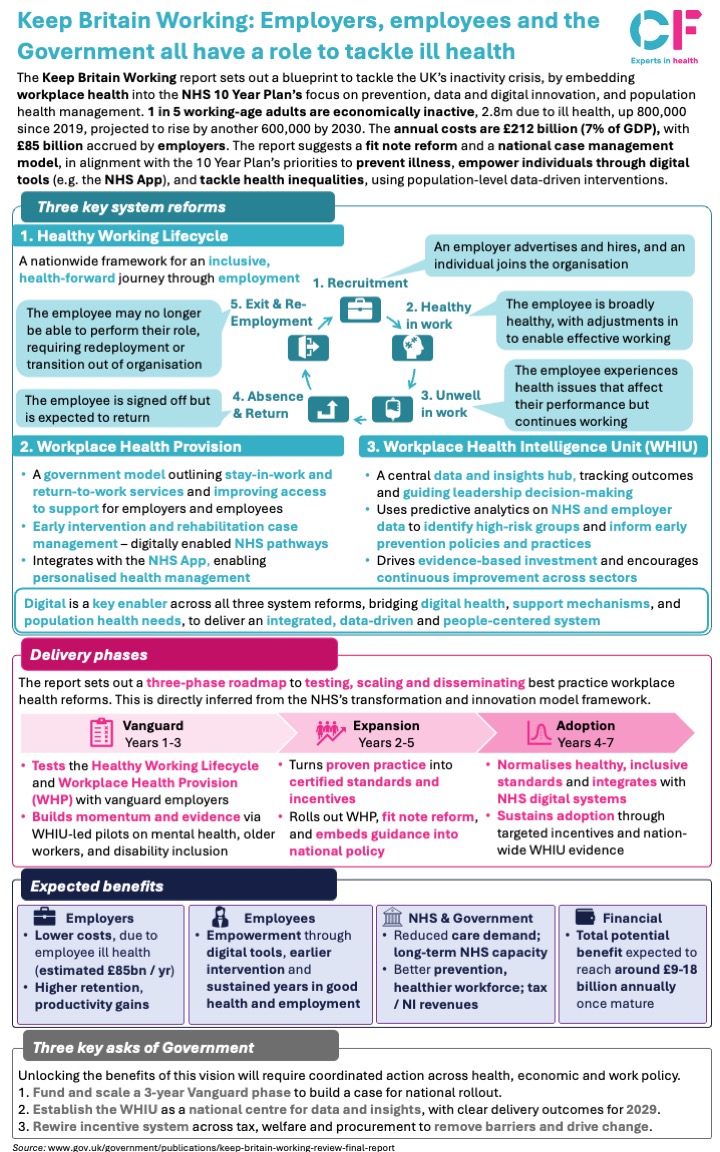1 in 5 working-age adults are currently economically inactive, 2.8m of those due to ill health, costing the economy an estimated £212 billion per year, or 7% of GDP. The UK Government’s “Keep Britain Working” report outlines an ambitious blueprint to tackle the country’s inactivity crisis. The report calls for embedding workplace health at the heart of NHS policy and broader population health strategy policymaking.
CF’s latest Snapshot distils the report’s findings into key insights for health, government, and employer leaders seeking to build a healthier, more productive workforce.
Why the government acted
The UK is facing rising ill health, NHS demand and capacity pressures and increasing labour market inactivity. Tackling these challenges requires a coordinated effort across employment, health and economic policymaking. The report’s findings align with the NHS 10-Year Plan’s vision for prevention before treatment, identifying three system reforms, instrumental to tackling inactivity and ill health.
Key headlines
1. Three key reforms
- Healthy Working Lifecycle – a five-step nationwide framework for an inclusive, health-forward journey through employment.
- Workplace Health Provision – a government-backed model improving access to employee health support and enabling digitally connected NHS pathways for early intervention and sustained work participation.
- Workplace Health Intelligence Unit – central data and insights hub, tracking outcomes and guiding leadership decision-making
2. The economic implications
- Ill health in working-age adults is costing the UK economy an estimated £212 billion per year. For employers alone, the impact amounts to around £85 billion annually in lost productivity and absence costs.
- If fully implemented, the report’s recommendations would deliver an estimated £9-18 billion in net benefits annually, through higher retention, productivity gains and reduced NHS demand.
3. A roadmap for reform
The report proposes a three-phase approach to pilot, scale and disseminate best practice workplace health interventions across sectors:
- Vanguard (Years 1–3) – Pilot programmes and digital integration with NHS services.
- Expansion (Years 2–5) – Building evidence, refining standards, and scaling successful models.
- Adoption (Years 4–7) – Embedding reforms into national policy, incentives, and digital systems.
Download our snapshot below for a full summary:
Why does it matter?
Unlocking these benefits requires alignment across health, economic and employment policy, building the foundations for a healthier, more resilient and inclusive workforce. A healthier workforce means a stronger economy, and digital innovation is at the core of bridging people, data and systems at scale.
- For employers, it means higher productivity and reduced costs.
- For employees, earlier access to care and sustained participation in work.
- For the NHS and Government, reduced demand, better prevention, and a more sustainable health system.
To find the full report click here.







